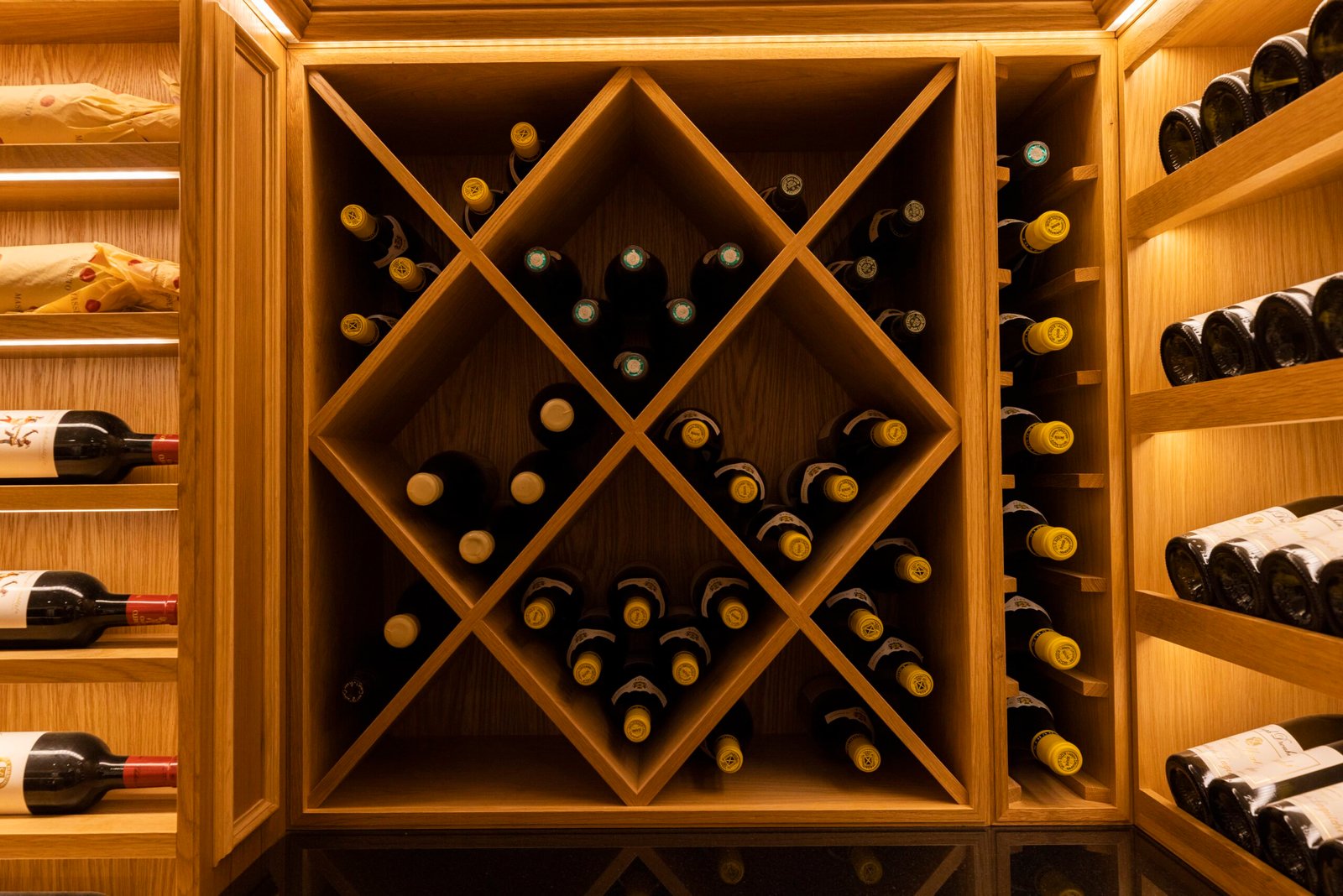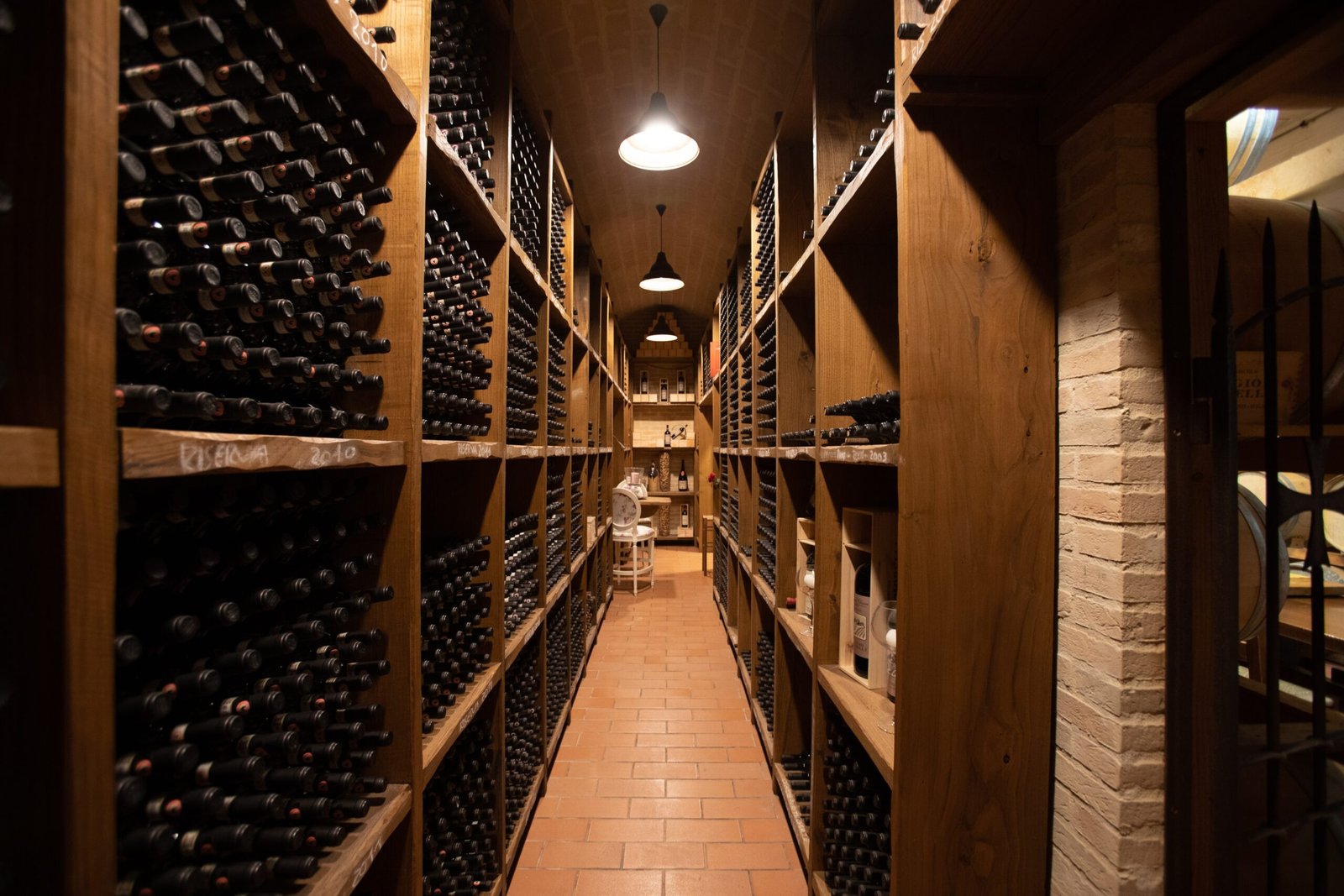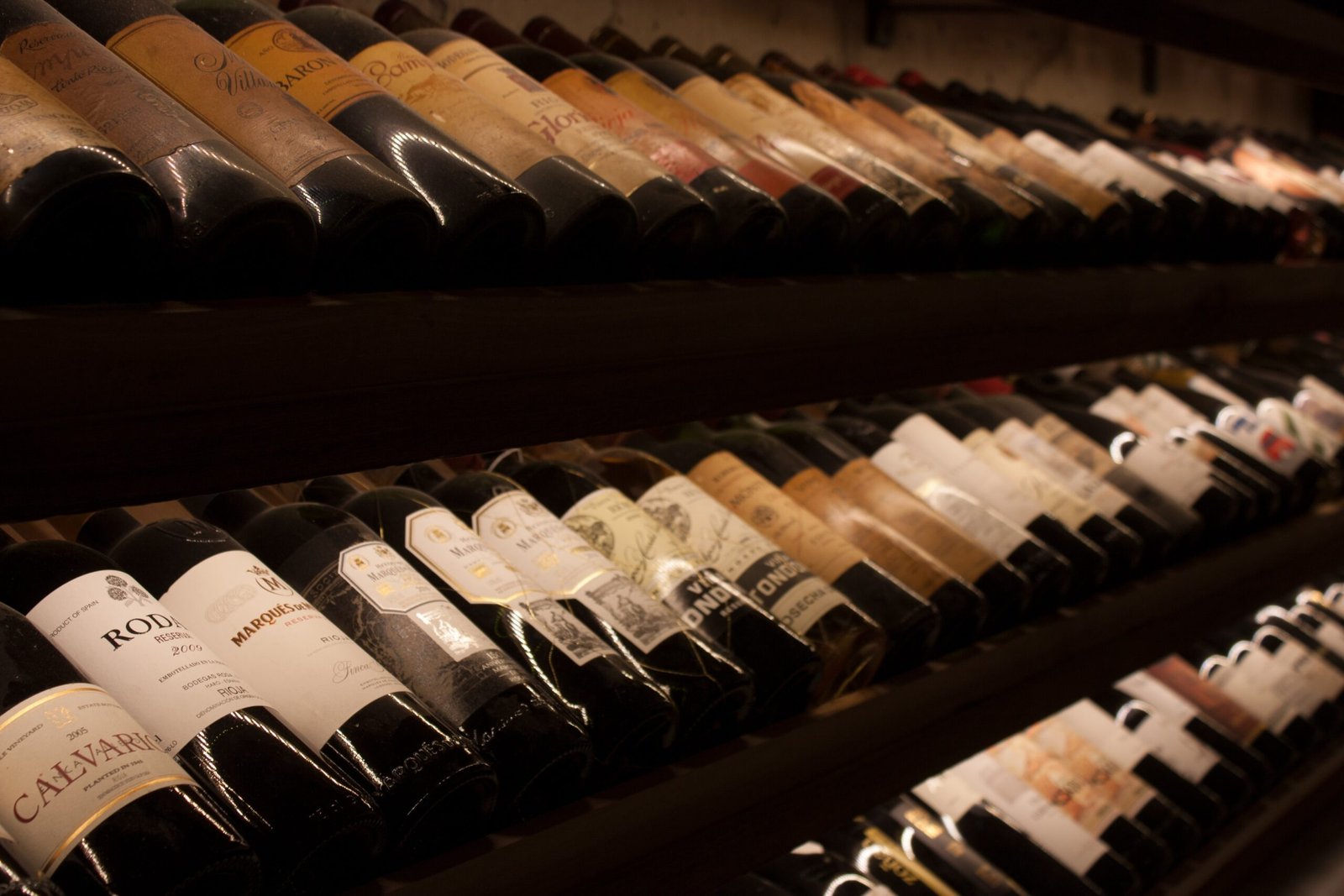How much will building a wine cellar cost you?
Unfortunately, there’s no one-size-fits-all answer for this; a wine cellar is unique and can be fully customisable according to the owner’s needs and preferences.
Thus, there are many different factors that can influence the cost of building your wine cellar, from location to the size of the room to various custom features you’d like to add to the room.
Yet, building a wine cellar might be more affordable than your initial thought. According to Checkatrade, the average cost of a wine cellar in the UK is £35,000, while according to Real Homes, the national average is £45,000 for a 75 sq ft wine cellar in the basement. In fact, you can technically build a simple, pull-up wine cellar for below £12,000, provided you have a suitable space.
With that being said, in this guide, we will discuss the different cost factors that may affect the cost of a wine cellar, as well as some actionable tips on how to build a cost-effective wine cellar to cater to your collections. Further below, we will also answer some FAQs surrounding designing and building a wine cellar.
Without further ado, let us begin this guide right away.
Wine Cellar Cost Factors: Overview
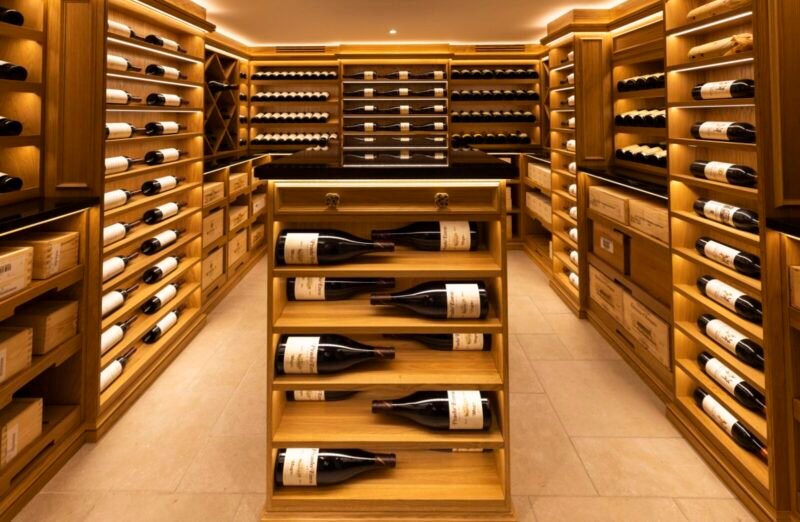
Again, while a wine cellar can be fully customisable and may have unique cost factors, below are the top 10 cost influencers when building a typical wine cellar:
- Location: if you are purchasing/renting space outside your home, then this can be a very substantial cost. However, different locations within the same house can also cost very differently (i.e., setting up an underground wine cellar will be much more expensive than purchasing simply a wall wine rack)
- Flooring and wall: total floor and wall costs can be substantial depending on the size of your wine cellar and can cost more than £6,000 based on the material and size of the room.
- Size: pretty self-explanatory; the bigger the wine cellar is, the more expensive it will be.
- Design: cellars involving basic wine cabinets will be more affordable than more complex designs like a walk-through cellar or building a tasting room.
- Insulation and temperature/humidity control: air-tight insulation can cost more than £5,000 per cellar, and you may also need to invest in humidifiers, vapour barriers, and other pieces of equipment.
- Storage capacity: as a general rule of thumb, a wine cellar with basic designs should cost between £500 and £800 per square foot or £650/sq ft on average.
- Cooling systems: there are three basic cooling system types for wine cellars; through-the-wall, split, and ducted systems, each with its own pros and cons. Ducted systems are considered the highest in capacity with very low noise but are also the most expensive option out of the three. Through-the-wall system is the most affordable but is only suitable for smaller cellar installations.
- Racking style and material: different racking styles and materials (i.e., wood, metal, glass) can vary a lot in cost, from as low as £3 per bottle to more than £25 per bottle.
- Door size, thickness, and material: again, pretty self-explanatory; the thicker, bigger, and stronger the door is, the more expensive it will be. Installing multiple doors will also translate into more costs.
- Lighting: basic lighting fixtures and installation for your wine cellar should cost between £200 and £1000, or £600 on average, depending on the size of the room.
Below, we will discuss these cost factors one by one in a more detailed manner, starting with arguably the most important one: location.
Wine Cellar Cost Factor: Location

The short answer is, yes, you can definitely store any kind of wine in your wine cellar.
Assuming you are going to build the wine cellar within your home, there are several locations you can consider within the house, some more expensive to build than others.
While you can technically build the wine cellar anywhere, ideally, the wine cellar should be built in a location that is:
- Has a stable temperature of between 11-14˚C. The temperature should never go above 24°C at all cost
- Has a controlled relative humidity (RH) of 50-70%, with 60% being the ideal
- Not exposed to natural sunlight
- Very minimum to no vibrations
- Not exposed to unwanted odour
After considering these factors, the most popular locations to build a wine cellar are:
- Basement: the most popular option since it’s not exposed to direct sunlight and the temperature/humidity is easier to control. Remodelling your basement into a wine cellar may cost you from under £10,000 to above £40,000, depending on size and other factors
- Wall wine rack: you can build a wall wine rack in your pantry or other relatively small spaces, especially if the wine bottles will be frequently consumed rather than collected. Basic wine rack models (ready-made) can cost below £700, but bespoke models can be more expensive than £5,000
- Underground: the wine cellar is built into the floor and can be pulled up (or automatically moved with machinery.) This type will cost around £15,000 in total, but alternatively, you can build a large underground cellar with a walk-down staircase, which can cost above £80,000.
- Under stairs: another viable option for houses with limited spaces, but you may need to deal with unstable temperatures and humidity (which can translate to extra costs in insulation.) Under-stair wine racks can cost below £4,000, as low as under £800.
- Walk-in closets: you can convert unused closets into a wine cellar, which can be ideal since most walk-in closets don’t have windows (no direct sunlight.) You’ll need to remodel the closet for airtight insulation and air conditioning, which may cost around £3,000 and above, depending on the size of the closet.
- Crawl-in space: again, while you can convert unused crawl spaces into a wine cellar, you’ll need to install humidity/temperature control and additional insulation. Depending on size, renovating the crawl-in space for insulation will cost around £500 to £2,000.
Controlling temperature and humidity, as you can see, can be very challenging in practice, and you may end up needing to remodel the whole space and invest in vapour barriers, air conditioning, and insulation, among others, which can add up to the overall cost of the wine cellar.
This is why it’s very important to build your wine cellar in a proper location from the start, and in most cases, the basement is the most ideal location due to it having a lower temperature and more stable humidity than the rest of the house. The basement’s humidity is typically around 70%, versus only 30% in the average living room.
Wine Cellar Cost Factor: Floors and Walls
There are two factors dictating your flooring costs: the size of the room and the material.
A crucial consideration when choosing floor materials for the wine cellar is that it needs to be adequately sealed, or else your wine collection can be spoiled.
Concrete is naturally sealed, making it an ideal option for most wine cellars, but there are also other viable options like vinyl, hardwood, porcelain, stone, or others. Keep in mind, however, that softer materials can be more forgiving in accidents when you drop a bottle, and not to mention they tend to be more affordable.
Harder surfaces (like tile or concrete), however, are much easier to clean while also being naturally less porous.
Wall renovation requirements would depend on the size of your space and your location. You’d want wall materials that offer high enough insulation, and glass and wood materials are typically the most ideal options. While you can technically use concrete walls, you’ll need to coat them to ensure insulation, which can add up to overall costs.
Many wine collectors nowadays prefer glass walls (and even floors) on their wine cellars for aesthetic purposes. If you decide on these glass materials, expect to pay around 20% higher than other materials. You’ll need a special glass material that blocks out natural light (and UV), and you’ll need them to be thick enough to provide adequate insulation.
In general, when it comes to floors and walls for your wine cellar:
- Expect around £2,000 to £6,000 in flooring for a standard basement wine cellar
- Expect between £2,000 and £4,000 in wall renovation; and between £3 and £10 per square foot for insulation
- You’ll need a premium humidity management system for glass walls to prevent condensation
Wine Cellar Cost Factor: Size
The size of your wine cellar will dictate other costs, including flooring and wall renovation—as discussed above—and cooling system requirements.
The average cost of building a wine cellar is between £500 and £800 per square foot.
Keep in mind that the size of the wine cellar will directly affect the storage capacity. In general, a 1/2 square foot of space can safely hold ten bottles. If, for example, you’d want a cellar capable of storing 500 bottles, then you’ll need a 25 sq ft space, and the average cost of building a wine cellar of this size will be £20,000 (assuming a £800/sq ft cost.)
Wine Cellar Cost Factor: Design
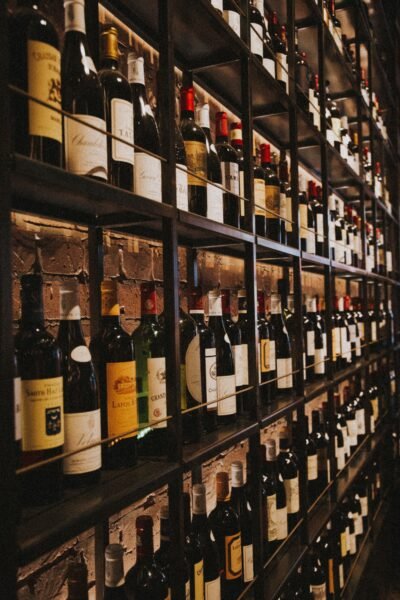 You can choose between many different design approaches depending on your aesthetic and functional preferences.
You can choose between many different design approaches depending on your aesthetic and functional preferences.
Below are the most popular types of wine cellar designs and their average costs:
- Spiral staircase design. Common for underfloor and crawl-space wine cellars. Can cost under £2,000 for smaller staircases, but high-end or large staircases can cost upwards of £70,000.
- Tasting room: you can set up a dedicated tasting area outside the cellar. Setting up a home wine-tasting room is between £60,000 and £200,000.
- Wine bar: you can set up a home wine bar, with roughly similar costs to building a tasting room.
- Trap door: for houses with limited spaces, or if you’d like more security, you can build the wine cellar underground with trap door access. Will cost around £40,000 to £200,000 to build.
Wine Cellar Cost Factor: Insulation and Humidity Control
Controlling and maintaining humidity is critical in any wine cellar, and the cost of doing so can be substantial.
An ideal wine cellar should maintain a steady humidity between 50 and 70 percent, which can be achieved in several steps:
- Installing an appropriate humidifier. This can cost above £1,000 for a large enough basement
- Furring—or framing—is the process of raising surfaces by installing strips of wood to prevent dampness and provide space for insulation. Furring cost starts at around £4 per square foot.
- To create an airtight space, it’s typically necessary to install a green board (a specific type of drywall); you may also need to use a vapour barrier before installing the installation. In total, installation costs range from £5,000 to £30,000, depending on the insulation material used and the size of the room.
Wine Cellar Cost Factor: Cooling System
A cooling unit is essential to maintain a controlled temperature between 11-14˚C and not more than 15˚C, which can be achieved by installing a thermostat (around £100 to £250) and a cooling unit.
There are three different types of cooling systems to choose from, each with its advantages and disadvantages.
1. Through-the-wall cooling system
The most affordable type and also the easiest to install. As the name suggests, the cooling unit goes through the walls of the wine cellar, sitting between rooms.
The main advantage of this type of unit is its easy and affordable installation. You don’t need the help of a licensed HVAC technician, and it can be installed by a handyman. The unit is also more affordable than the other types and can usually be installed without needing major renovation to the room.
However, it is also noisier than the other types, and can’t cool down larger wine cellars.
2. Split cooling system
This type of unit is quieter than a through-the-wall unit since the evaporator is separated from the condenser (hence the name ‘split.’ You can place the noisy and hot condenser further away from the cellar, giving you more versatility In controlling your temperature.
However, it is also more expensive than a through-the-wall, and installing a split system would require the help of a licensed HVAC technician.
3. Ducted cooling system
A ducted cooling system offers the most versatility in both accommodating aesthetic design and providing quiet cooling. Another key advantage to the ducted system is that we can integrate humidifiers with it, ensuring more long-term convenience.
However, installing the ducted system is generally more expensive, especially after considering the required ductwork. Installation is also typically more complex and will require full access behind the walls or ceiling, and you may be legally required to get help from a certified HVAC technician.
Wine Cellar Cost Factor: Racks
 Regardless of your location and design approaches, you’ll need at least one wine rack in the cellar.
Regardless of your location and design approaches, you’ll need at least one wine rack in the cellar.
Wine racks come in various styles, shapes, and sizes. You can either purchase ready-made racks or get them custom-made to suit your space’s specific shape. Of course, these custom-made racks are typically more expensive and can cost between £800 and £4,000 for each piece.
Pre-fabricated racks, on the other hand, are typically more affordable and can be under £300 for small (less than ten bottles) racks.
When choosing or building custom-made racks, keep in mind that wine bottles vary a lot in dimensions. Most wine bottles are around 12 inches tall and around 3 inches in diameter, so keep this in mind when deciding how many racks and how big your racks should be.
In general, expect your racks to cost between £3 and £25 per bottle space.
Wine Cellar Cost Factor: Door
Similar to floors and walls, the cost of your wine cellar doors will vary based on dimensions and material. Keep in mind that to maintain stable temperature and humidity, ideally, the door should be completely airtight.
For aesthetic reasons, many people now opt for glass doors (at least, doors with glass elements) for their cellar. Again, glass is more difficult to insulate, so expect to spend 20% more than you would with other materials.
In general, expect to pay between £800 and £6000 for an airtight and insulated door.
Wine Cellar Cost Factor: Lighting
As discussed, Basic lighting fixtures and installation for your wine cellar should cost around £600 per project on average, depending on the size of the room and the types of fixtures of your choice.
For aesthetics and functional reasons, you can also invest in custom lighting fixtures (i.e., chandeliers) as a part of your cellar’s decoration. However, avoid halogen lights (due to high UV) and stick with LED or fluorescent bulbs to avoid spoiling your vintages.
Wrapping Up
So, how much will building your perfect wine cellar cost?
Ultimately, the answer would depend on where and how you want to build your wine cellar.
Above, we have discussed the most important factors that would affect the cost of building your wine cellar:
- Location
- Flooring and wall renovation
- Size of the cellar
- Design
- Insulation and temperature/humidity control
- Storage capacity
- Cooling systems
- Racking style and material
- Door size, thickness, and material
- Lighting
By figuring out your needs and preferences in these ten different areas, you can start planning the perfect wine cellar according to your budget.
Looking to build a bespoke wine cellar, racks, or wine rooms for your collection? Contact Leessa or make an appointment to visit our London showroom right away.

